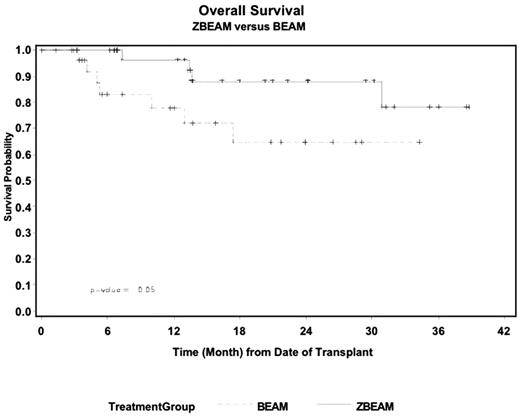Abstract
Background: ASCT is an effective treatment for patients with high risk NHL. However, relapse rates remain high. Attempts at further dose intensification are limited by regimen-related toxicity especially in older patients. Zevalin as a single agent has showed activity in aggressive Non-Hodgkin’s Lymphoma (NHL). We therefore, devised a novel conditioning regimen (Z-BEAM) combining standard dose Zevalin (0.4mci/kg) with high dose BEAM (BCNU 150mg/m2 day-7,-6, cytarabine 800mg/m2 and etoposide 800mg/m2 day-5 to day-2, and melphalan 140mg/m2 day-1).
Herein, we provide an update on the study and also retrospectively compare this new conditioning regimen with conventional high dose BEAM in older patients (age >=50). Between 1995 and 2005, 65 patients (BEAM n=32, Z-BEAM n=33) underwent ASCT utilizing these regimens. Patient selection was similar for Z-BEAM and BEAM. Patients received BEAM prior to the opening of the Z-BEAM protocol and similiarly after the Z-BEAM protocol completed accrual. The groups were well matched for most demographics and disease status. Median age: Z-BEAM - 62 yrs (range 50–78), BEAM - 64 yrs (range 50–77); 1st CR/PR pts comprised 45% in the Z-BEAM arm and 34% in the BEAM, > =1st Relapse 42% vs 50% and induction failure 12% vs 15%. (p=0.7). Median number of prior regimens was 3 in the Z-BEAM group vs 2 in the BEAM arm.(p=0.08) 54 % had bulky disease at diagnosis in the Z-BEAM group vs 41% in the BEAM group (p=0.30).
Results: Two-year OS was 78% for all pts (95%CI, 67–86). Two-year OS/PFS in the Z-BEAM group was 88%(95% CI, 70–95)/72 %(95% CI, 57–83) respectively vs 65% (95%CI, 48–77)/ 67%( 95CI, 50–79) in the BEAM group (Figure1). Analysis by histology showed that in patients with diffuse large B-cell lymphoma (DLBCL), there was a significant difference in OS/PFS of Z-BEAM vs BEAM, 95% vs 48% at 2 yrs (p=.009)/ 88% vs 48% ( p=0.015). The OS/PFS difference of Z-BEAM vs BEAM in patients with mantle cell lymphoma did not reach significance. The toxicity profile and transplant related mortality was similar in both regimens.
Conclusions: Our study suggests that the addition of Zevalin to the BEAM conditioning regimen is feasible and well tolerated in older patients. The favorable outcome of patients treated with Z-BEAM compared with BEAM alone, especially in patients with DLBCL, suggests that prospective study in a randomized trial is warranted.
Overall Survival ZBEAM versus BEAM
Disclosures: Use of Zevalin as part of transplant conditioning.; Dr Molina is an employee of Biogen Idec.; Dr Raubitschek has served as a consultant to BIogen IDEC.; Dr Molina has stock options in Biogen Idec.; Drs Krishnan, Nademanee, Raubitschek have received research funding from Biogen Idec.
Author notes
Corresponding author


This feature is available to Subscribers Only
Sign In or Create an Account Close Modal